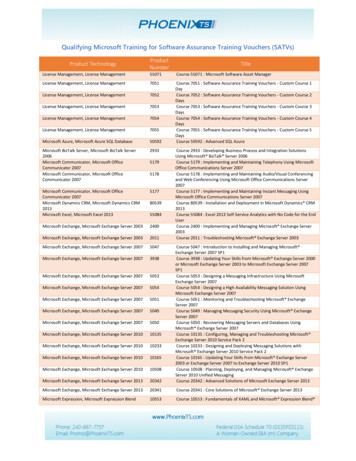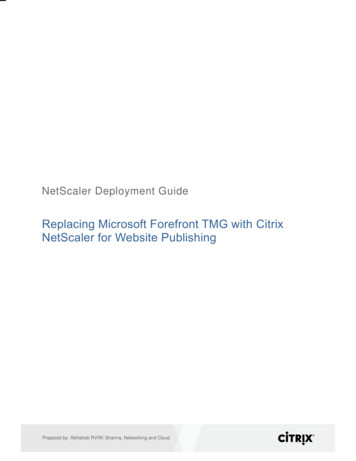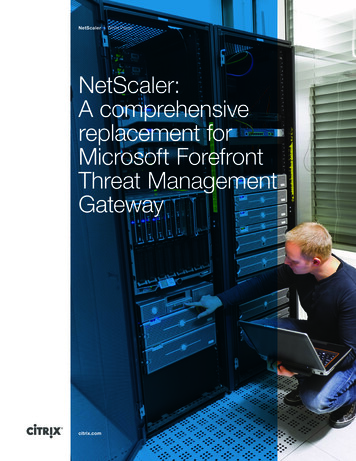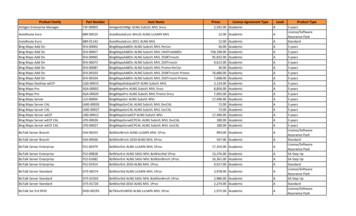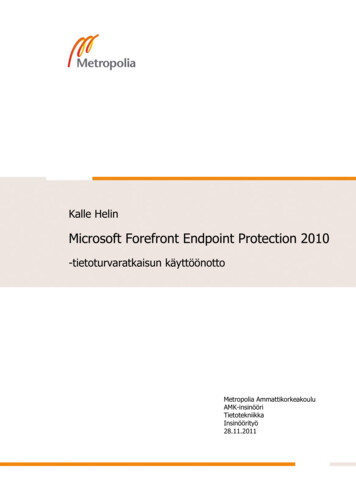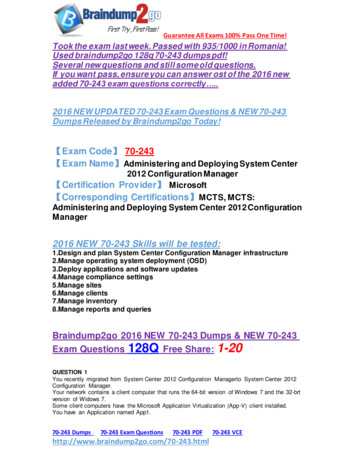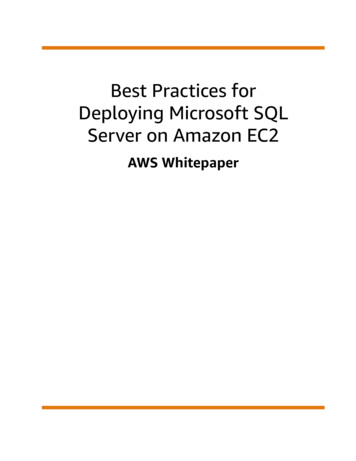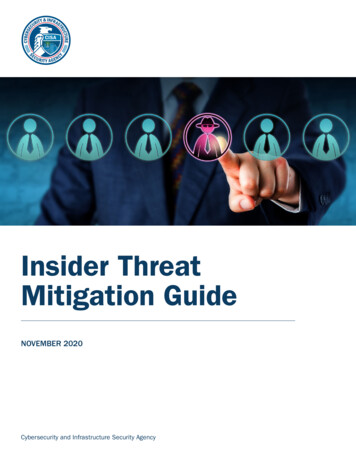
Transcription
PUBLISHED BYMicrosoft PressA Division of Microsoft CorporationOne Microsoft WayRedmond, Washington 98052-6399Copyright 2010 by Yuri Diogenes and Dr. Thomas W. ShinderAll rights reserved. No part of the contents of this book may be reproduced or transmitted in any form or by anymeans without the written permission of the publisher.Library of Congress Control Number: 2010936127Printed and bound in the United States of America.Microsoft Press books are available through booksellers and distributors worldwide. For further infor mation aboutinternational editions, contact your local Microsoft Corporation office or contact Microsoft Press Internationaldirectly at fax (425) 936-7329. Visit our Web site at www.microsoft.com/mspress. Send comments to mspinput@microsoft.com.Microsoft and the trademarks listed at ctualProperty/Trademarks/EN-US.aspx are trademarks of the Microsoft group of companies. All other marks are property oftheir respective owners.The example companies, organizations, products, domain names, e-mail addresses, logos, people, places, andevents depicted herein are fictitious. No association with any real company, organization, product, domain name,e-mail address, logo, person, place, or event is intended or should be inferred.This book expresses the author’s views and opinions. The information contained in this book is provided withoutany express, statutory, or implied warranties. Neither the authors, Microsoft Corporation, nor its resellers, ordistributors will be held liable for any damages caused or alleged to be caused either directly or indirectly bythis book.Acquisitions Editor: Devon MusgraveDevelopmental Editor: Karen SzallProject Editor: Karen SzallEditorial Production: nSight, Inc.Technical Reviewer: Mitch Tulloch; Technical Review services provided by Content Master, a memberof CM Group, Ltd.Cover: Tom Draper DesignBody Part No. X17-15053
ContentsIntroductionChapter 1viiUnderstanding Forefront Threat ManagementGateway 20101A History of Perimeter Protection. . . . . . . . . . . . . . . . . . . . . . . . . . . . . . . . . . . 1Forefront TMG as a Perimeter Network Device. . . . . . . . . . . . . . . . . . . . . . . . 3Network Firewall3Forward and Reverse Proxy, Web Proxy, and WinsockProxy Server4Web Caching Server5Remote Access VPN Server5Site-to-Site VPN Gateway7Secure Email Gateway8Forefront TMG as a Secure Web Gateway. . . . . . . . . . . . . . . . . . . . . . . . . . . . 8Network Inspection System10Malware Inspection11HTTPS Inspection13URL Filtering15Forefront TMG Role within the Forefront Protection Suite. . . . . . . . . . . . . 16Forefront Unified Access Gateway 201017Forefront Identity Manager18Forefront Protection for Exchange Server19Forefront Online Protection for Exchange19Forefront Protection 2010 for SharePoint20Administrators Punch List. . . . . . . . . . . . . . . . . . . . . . . . . . . . . . . . . . . . . . . . . 20What do you think of this book? We want to hear from you!Microsoft is interested in hearing your feedback so we can continually improve our books and learningresources for you. To participate in a brief online survey, please visit:www.microsoft.com/learning/booksurvey/iii
Chapter 2Installing and Configuring Forefront ThreatManagement Gateway 201023Preparing to Install Forefront TMG. . . . . . . . . . . . . . . . . . . . . . . . . . . . . . . . . 23Choosing Deployment Options for Forefront TMG24Meeting Hardware and Software Requirements forForefront TMG25Selecting the Forefront TMG Edition29Installing Forefront TMG . . . . . . . . . . . . . . . . . . . . . . . . . . . . . . . . . . . . . . . . . 31Reviewing Company Requirements31Completing the Installation Phases32Installing Forefront TMG32Post-Installation Configuration. . . . . . . . . . . . . . . . . . . . . . . . . . . . . . . . . . . . . 42Administrator’s Punch List. . . . . . . . . . . . . . . . . . . . . . . . . . . . . . . . . . . . . . . . . 55Chapter 3Deploying Forefront TMG 2010 Service Pack 157New Features in Service Pack 1 . . . . . . . . . . . . . . . . . . . . . . . . . . . . . . . . . . . . 57Planning Service Pack 1 Deployment. . . . . . . . . . . . . . . . . . . . . . . . . . . . . . . 58Installing Forefront TMG 2010 Service Pack 1. . . . . . . . . . . . . . . . . . . . . . . . 59Configuring User Override for URL Filtering. . . . . . . . . . . . . . . . . . . . . . . . . 62Reporting Enhancements . . . . . . . . . . . . . . . . . . . . . . . . . . . . . . . . . . . . . . . . . 65Branch Office Support. . . . . . . . . . . . . . . . . . . . . . . . . . . . . . . . . . . . . . . . . . . . 66What’s Next?. . . . . . . . . . . . . . . . . . . . . . . . . . . . . . . . . . . . . . . . . . . . . . . . . . . . 72Administrator’s Punch List. . . . . . . . . . . . . . . . . . . . . . . . . . . . . . . . . . . . . . . . . 73What do you think of this book? We want to hear from you!Microsoft is interested in hearing your feedback so we can continually improve our books and learningresources for you. To participate in a brief online survey, please ents
AcknowledgmentsThis Forefront project took almost a year to write and resulted in three separatebooks about deploying Forefront products. Although the authors get lots ofcredit, there can be little doubt that we could not have even begun, much lesscompleted, this book without the cooperation (not to mention the permission) ofan incredibly large number of people.It’s here that we’d like to take a few moments of your time to express our gratitude to the folks who made it all possible.With thanks To the folks at Microsoft Press who made the process as smooth as they possiblycould: Karen Szall, Devon Musgrave, and their crew.To the TMG Product Team folks, especially to Ori Yosefi and David Strausberg,for helping us by reviewing the Service Pack 1 chapter. To all our friends from CSSSecurity, especially to Bala Natarajan for reviewing content.From YuriFirst and foremost to God, for blessing my life, leading my way, and giving methe strength to take on the challenges as just another step in life. To my eternalsupporter in all moments of my life: my wife Alexsandra. To my daughters who,although very young, understand when I close the office door and say, “I’m reallybusy.” Thanks for understanding. I love you, Yanne and Ysis.To my friend Thomas Shinder, whom I was fortunate enough to meet threeyears ago. Thanks for shaping my writing skills and also contributing to mypersonal grown with your thoughts, advice, and guidance. Without a doubt,these long months working on this project were worth it because of our amazingpartnership. I can’t forget to thank the two other friends who wrote the MicrosoftForefront Threat Management Gateway Administrator’s Companion with me: JimHarrison and Mohit Saxena. They were, without a doubt, the pillars for this writingcareer in which I’m now fully engaged. Thanks, guys. To, as Jim says, “da Boyz”:Tim “Thor” Mullen, Steve Moffat, and Greg Mulholland. You guys are amazing.Thanks for sharing all the tales.To my friend Thomas Detzner and all ISA/TMG EMEA engineers (including thegreat folks from PFE), thanks for sharing your knowledge and all the partnershipsthat we have had over these years. I would also like to say thanks to all my friendsv
from Microsoft CSS Security (in Texas, North Carolina, and Washington) for sharing experiences every day, with a special thanks to all the great engineers fromCSS India—you guys are the pillars of this team. Thanks for pushing me withtough questions and concerns. To all the readers of my articles and blogs, thanksfor all the feedback that you guys share with me. If I keep writing in my sparetime, it is because I know you are reading it. To all the Forefront MVPs, keep upthe amazing job that you guys do. Last, but not least, to my buddies Mohit Kumar,Alexandre Hollanda, Daniel Mauser, and Alejandro Leal, for your consistent support throughout the years.From TomAs Yuri does, I acknowledge the blessings from God, who took “a fool like me”and guided me on a path that I never would have chosen on my own. The secondmost important acknowledgement I must make is to my beautiful wife, Deb Shinder, whom I consider my hand of God. Without her, I don’t know where I wouldbe today, except that I know that the place wouldn’t be anywhere near as good asthe place I am now.I also want to acknowledge my good friend Yuri Diogenes, my co-writer onthis project. Yuri really held this project together. I had just started working forMicrosoft and was learning about the ins and outs of the Microsoft system, andI was also taking on a lot of detailed and complex projects alongside the writingof this book. Yuri helped keep me focused, spent a lot of time pointing me in theright direction, and essentially is responsible for enabling me to get done what Ineeded to get done. I have no doubt that, without Yuri guiding this effort, it probably never would have been completed.Props go out to Jim Harrison, “the King of TMG,” as well as to Greg Mulholland,Steve Moffat, and Tim Mullen. You guys were the moral authority that drove usto completion. I also want to give a special “shout out” to Mohit Saxena. His TMGchops and sense of humor also helped us over the finish line.Finally, I want to thank the operators of ISAserver.org and all the members ofthe ISAserver.org community. You guys were the spark that started a flaming hotcareer for me with ISA Server and then TMG. You guys are a never-ending inspiration and a demonstration of the power of community and ways communities canwork together to solve hard problems and share solutions.vi
IntroductionWhen we began this project, our intent was to create a real world scenariothat would guide IT professionals in using Microsoft best practices to deploy Microsoft Forefront Threat Management Gateway (TMG) 2010. We hopeyou find that we have achieved that goal. We’ve also included the main deployment scenarios for Forefront TMG, and we take a deep dive into the installationprocess from the RTM version to the Service Pack 1 version.This book provides administrative procedures, tested design examples, quickanswers, and tips. In addition, it covers some of the most common deploymentscenarios and describes ways to take full advantage of the product’s capabilities.This book covers pre-deployment tasks, use of Forefront TMG in a Secure WebGateway Scenario, software and hardware requirements, and installation andconfiguration, using best practice recommendations.Who Is This Book For?Deploying Microsoft Forefront Threat Management Gateway 2010 covers the planning and deployment phases for this product. This book is designed for: Administrators who are deploying Forefront TMGAdministrators who are experienced with Windows Server 2008 in generaland with Windows networking in particular Current ISA Server administrators Administrators who are new to Forefront TMG Technology specialists, such as security administrators and network administratorsBecause this book is limited in size and we want to provide you the maximumvalue, we assume a basic knowledge of Windows Server 2008 and Windowsnetworking. These technologies are not discussed in detail, but this book containsmaterial on both of these topics that relates to Forefront TMG administrativetasks.How Is This Book Organized?Deploying Microsoft Forefront Threat Management Gateway 2010 is written to bea deployment guide and also to be a source of architectural information relatedto the product. The book is organized in such a way that you can follow the stepsvii
to plan and deploy the product. The steps are based on a deployment scenariofor the company Contoso. As you go through the steps, you will also notice tipsfor best practices implementation. At the end of each chapter, you will see an“Administrator’s Punch List,” in which you will find a summary of the main administrative tasks that were covered throughout the chapter. This is a quick checklistto help you review the main deployment tasks.The book is organized into three chapters: Chapter 1, “UnderstandingF orefront Threat Management Gateway 2010,” introduces you to the core concepts of firewalls, perimeter protection, and proxies and guides you throughthe use of Forefront TMG as a secure web gateway. Chapter 2, “Installing and Configuring Forefront Threat Management Gateway 2010,” guides you throughthe product’s installation and configuration. Chapter 3, “Deploying Forefront 2010Service Pack 1,” covers the new features of Service Pack 1 and describes how toinstall and configure those features.We really hope you find Deploying Microsoft Threat Management ateway 2010 useful and accurate. We have an open door policy for email atGmspress.tmgbook@tacteam.net, and you can contact us through our personalblogs and Twitter accounts: http://blogs.technet.com/yuridiogenes and com/yuridiogenes and http://twitter.com/tshinderSupport for This BookEvery effort has been made to ensure the accuracy of this book. As corrections orchanges are collected, they will be added to the O’Reilly Media website. To findMicrosoft Press book and media corrections:1.Go to http://microsoftpress.oreilly.com.2.In the Search box, type the ISBN for the book and click Search.3.Select the book from the search results, which will take you to the book’scatalog page.4.On the book’s catalog page, under the picture of the book cover, clickView/Submit Errata.If you have questions regarding the book or the companion content that arenot answered by visiting the book’s catalog page, please send them to MicrosoftPress by sending an email message to mspinput@microsoft.com.viii
We Want to Hear from YouWe welcome your feedback about this book. Please share your comments andideas through the following short yYour participation helps Microsoft Press create books that better meet yourneeds and your standards.NOTEWe hope that you will give us detailed feedback in our survey. If youhave questions about our publishing program, upcoming titles, or MicrosoftPress in general, we encourage you to interact with us using Twitter athttp://twitter.com/MicrosoftPress. For support issues, use only the email address shown earlier.ix
CHAPTER 3Deploying Forefront TMG2010 Service Pack 1 New Features in Service Pack 1 57 Planning Service Pack 1 Deployment Installing Forefront TMG 2010 Service Pack 1 Configuring User Override for URL Filtering Reporting Enhancements Branch Office Support What’s Next? 725859626566In the summer of 2010, Microsoft released a major product update: Forefront TMG2010 Service Pack 1 (SP1) for Microsoft Forefront Threat Management Gateway (TMG)2010. This service pack is intended to not only fix some issues that were detected afterForefront TMG was released, but also add new capabilities to the product. This chapterdescribes the new features, the way to install Forefront TMG 2010 SP1, the way to deploythe core features available in this service pack, and what’s coming next.New Features in Service Pack 1Forefront TMG 2010 SP1 provides improvements to Forefront TMG in four core areas: Reporting Forefront TMG 2010 SP1 changes the look and feel of ForefrontTMG reports and adds a new user activity report that can show more detailedinformation about the pages a user browsed and the URL categories that wererequested by the user.Secure Web Access One of the main uses for Forefront TMG is as a SecureWeb Gateway (SWG). One of TMG’s core features, called URL Filtering, is a keycomponent of SWG. Forefront TMG 2010 SP1 brings a new capability, called URLFiltering User Override, to this feature. URL Filtering User Override allows users tooverride the access restrictions put in place by the URL Filtering feature implemented by the TMG administrator.57
Branch Office Support Forefront TMG 2010 SP1 takes advantage of the ranchCache feature that is available in Windows Server 2008 R2. This feature providesBbranch office users with an improved browsing experience while reducing bandwidthutilization between the branch and main offices. Publishing A new publishing wizard supports SharePoint 2010 deploymentsthrough Forefront TMG.These features will be covered in detail in this chapter. However, before we discuss newfeatures, it is important to get more details on Forefront TMG 2010 SP1 deployment.Planning Service Pack 1 DeploymentBefore installing Forefront TMG 2010 SP1 on Forefront TMG, it is necessary to plan thedeployment to ensure that it goes smoothly. The installation sequence and prerequisites willvary according to your TMG setup. The overall installation process is shown in Figure 3-1:FIGURE 3-1In order to carry out the Forefront TMG 2010 SP1 installation procedures correctly, you willneed to answer the following questions:58 Which Forefront TMG version (Enterprise or Standard) are you using? Are the Forefront TMG firewalls deployed as array members or as stand-alone servers? What Forefront TMG role (EMS or Firewall) is the machine providing?CHAPTER 3Deploying Forefront TMG 2010 Service Pack 1
When you have this information, you can determine the installation sequence fromTable 3-1.NOTEBefore you apply Forefront TMG 2010 SP1, create a full backup of your currentForefront TMG configuration. You should also have the latest Windows updates installedon the computer on which TMG is installed.TABLE 3-1 Installation based on the Forefront TMG setupTMG SETUPINSTALLATION ORDERGENERAL NOTESSingle Server1.Single server installation Regardless of the Forefront TMG setup,always run the setup with an elevatedpointadministrative level.Array1.Enterprise ManagementServers (master andreplicas)2.Array managers3.Array membersBefore you install Forefront TMG 2010 SP1on Forefront TMG Enterprise Edition, youmust log on to EMS using the credentialsthat were used to install EMS during theinitial setup process. If you try to installthe update using a different administrator account, the installation might fail.Installing Forefront TMG 2010 Service Pack 1Assuming that you downloaded Forefront TMG 2010 SP1 in English—from the MicrosoftDownload Center amilyID f0fd5770-7360-4916-a5be-a88a0fd76c7c&displaylang en) to a temporary folder, such as C:\temp—start the installation by following these steps:1.Click Start, right-click Command Prompt, and choose the Run As Administrator option.2.Type cd c:\temp to switch to the temporary folder.3.Type TMG-KB981324-AMD64-ENU.msp, and press Enter.4.On the Open File – Security Warning page, click Open.5.When the Welcome To The Update For Microsoft Forefront TMG Service Pack 1 pageappears, as shown in Figure 3-2, click Next to continue.Installing Forefront TMG 2010 Service Pack 1CHAPTER 359
FIGURE 3-26.When the License Agreement page appears, read the license agreement and selectthe I Accept The Terms In The License Agreement checkbox, and then click Next toproceed.7.The Locate Configuration Storage Server page appears. Because this is the first Forefront TMG to which we are applying Forefront TMG 2010 SP1, the option to specify the configuration storage server is unavailable (grayed out), as shown in Figure 3-3.When you are applying Forefront TMG 2010 SP1 on array members, this option willbe available so that you can specify the configuration storage server. Click Next to continue.FIGURE 3-360CHAPTER 3Deploying Forefront TMG 2010 Service Pack 1
8.When the Ready To Install The Program page appears, click Install.9.After the installation is finished, the Installation Wizard Completed page appears, asshown in Figure 3-4. Click Finish to conclude the installation.FIGURE 3-410.To confirm that the Forefront TMG 2010 SP1 installation is in place, you can open theForefront TMG Management console, click System, and verify the Forefront TMG version, which should be 7.0.8108.200, as shown in Figure 3-5.FIGURE 3-5Administrator's Insight: Troubleshooting an InstallationThere are several issues that you might encounter when installing ForefrontTMG 2010 SP1, some of which are documented in the Forefront TMG 2010 SP1release notes at 43.aspx#troubleshooting). There may be other problems with the installation that willrequire troubleshooting. The general rule of thumb is to start troubleshooting theinstallation by reviewing the error messages presented in the UI, and then go to theForefront TMG setup logs to track the root causes of the issues. The Forefront TMGSetup Installation logs are located at %windir%\temp, and the ADAM Setup log filesare located at %windir%\debug.Installing Forefront TMG 2010 Service Pack 1CHAPTER 361
There are two articles on the TMG Team Blog and one on my blog that describe ageneral approach to troubleshooting installation issues: "Troubleshooting ERROR: Setup failed to install ADAM.\r\n (0x80074e46) and0x80070643 while trying to install TMG 2010" can be found at -install-tmg-2010.aspx. “Another TMG 2010 Installation failure with error 0x80070643” can be foundat /13/another-tmg-2010- installation-failure-with-error-0x80070643.aspx. “Unable to install Forefront TMG 2010 – Error 0x80074e46” can be found at r-0x80074e46.aspx.Although these articles are not specifically related to Forefront TMG 2010 SP1,they can be used as troubleshooting methodology for your installation process onForefront TMG.Configuring User Override for URL FilteringIn a world in which compliance and security policy enforcement are growing trends, havinga secure Web gateway that reflects your IT business requirements is a real advantage. One ofthe pillars for the Forefront TMG Secure Web Gateway scenario is URL Filtering, which directlyaffects user productivity by filtering traffic to unwanted destinations. A new enhancement tothe URL Filtering feature, introduced with Forefront TMG 2010 SP1, allows users to overriderestricted Web access and proceed on a per-request basis. This can provide a more flexible Web access policy by allowing users to decide whether to access a site that was initiallydenied to them. This can help reduce help desk calls, especially for Web sites that have beenincorrectly categorized.While this might sound too flexible when the subject is policy enforcement, the fact of thematter is that the user will receive a warning that a Web site being entered is prohibited andthat entering the Web site will be logged. This can help to reveal user Internet usage behaviorwhen accessing prohibited Web sites. This feature uses the logic illustrated in Figure 3-6.62CHAPTER 3Deploying Forefront TMG 2010 Service Pack 1
FIGURE 3-6When Forefront TMG sends the Deny page, as illustrated by Step 4, if the user clicks verride Access Restriction, Forefront TMG will allocate to the user's browser a cookie thatOwill accompany all subsequent Web requests to this domain, and the browser is triggered toreload the URL. Once Forefront TMG receives the Web request with the cookie, it will effectively disable the blocking rule for this particular Web request. It is important to understandthat the cookie will remain valid only for the length of the browser session or until the configured time-out period expires. The other important notes about this feature are: In order for the user override feature to work, one of the subsequent firewall policyrules must allow access to the requested destination.User override configuration requires that you create Deny rules; you cannot enable Allow rules with category exceptions and then enable a user override. The user override option only works for the HTTP protocol. User override is not supported for HTTPS traffic. You can’t customize the content type for the user override feature; the rule must applyto all types of HTTP content.Now that you know how the core functionality of this feature works, the next step is toimplement it by following these steps:1.Open the Forefront TMG Management console.2.Click Web Access Policy, right-click the rule that denies the traffic to a set of destinations (for this example we will use the default Deny rule created by the Web AccessPolicy Wizard), and choose Properties.3.Click the Action tab, and then select the Allow User Override option, as shown in Figure 3-7.Configuring User Override for URL FilteringCHAPTER 363
FIGURE 3-7NOTEYou can also specify a range of time during which the user can stay on theblocked URL. This is the time that the assigned cookie will be valid for the user.4.To customize the error message that the user will receive when attempting to browsea blocked URL, click Advanced. The Action Advanced Properties dialog box appears, asshown in Figure 3-8.FIGURE 3-85.Type your custom message, as shown in Figure 3-8, click OK, click OK again, and clickApply to commit the changes.Now that you’ve implemented this feature, you can perform a test using a client who istrying to browse a Web site that matches one of the categories specified on the Deny rule on64CHAPTER 3Deploying Forefront TMG 2010 Service Pack 1
which the user override feature is enabled. The user will receive an error message, and theOverride Access Restriction button will be available, as shown in Figure 3-9.FIGURE 3-9IMPORTANTIf you don’t have an Allow rule for this destination, the user won’t be ableto access this Web site even by clicking Override Access Restriction.Reporting EnhancementsOne of the most highly anticipated changes in Forefront TMG 2010 SP1 is the enhancementto the reporting feature. The new report design changes the look and feel of Forefront TMGreports, and the new format provides clearer information. Figure 3-10 shows an example ofthe new report main page.Reporting EnhancementsCHAPTER 365
FIGURE 3-10NOTEMore sample reports can be found in “Reporting Improvements in ForefrontTMG SP1,” at /15/reporting- improvements-in-forefront-tmg-sp1.aspx.The user activity report will contain more granular information about the Web sites thatthe user visited, including the URL category for each site.NOTEWhile writing this book, a Reporting issue was detected after installing TMG SP1.To view the problem and the solution for this problem, review Yuri Diogenes’s answer onthe following forum thread: 177809016.Branch Office SupportThe new Branch Office integration functionality uses a new wizard to help you take advantage of the Windows Server 2008 R2 BranchCache role. This option enables Forefront TMG toact as Hosted Cache Server in a branch office scenario. The Forefront TMG UI dashboard forbranch and Web cache utilization can be used for monitoring. To illustrate this feature and66CHAPTER 3Deploying Forefront TMG 2010 Service Pack 1
the capability to use a Read-Only Domain Controller (RODC) on Forefront TMG, we are goingto use the topology shown in Figure 3-11.FIGURE 3-11In order to prepare the RODC you will need to: Verify that you have network connectivity to the Headquarters Domain Controller(HQ DC) and that you set the branch server's DNS to the HQ DC.If the RODC role is already installed on the server located in the branch office, createa slipstream version of Forefront TMG with Forefront TMG 2010 SP1 to install on topof the RODC. If you try to prepare the RODC without the slipstream version, you willreceive the error message shown in Figure 3-12.Branch Office SupportCHAPTER 367
FIGURE 3-12 Verify that the server located in the branch office is already a member of the domain(in this case it is a member of contoso.com).Verify that the server located in the branch office uses the domain controller at headquarters as its DNS server.Verify that the certificate that will be used by the BranchCache feature is alreadyinstalled on Forefront TMG under Personal Store, which is under Certificates (Local Computer). Remember that the certificate must be trusted by the clients that are behind Forefront TMG in the branch office.With these elements in place, the first step is to enable the RODC role on the server onwhich Forefront TMG is installed to prepare the forest for RODC. To do that, the forest mustbe at a Windows Server 2003, Windows Server 2008, or Windows Server 2008 R2 functionallevel. You must run the adprep /rodcprep command on the current domain controller forthe domain.After preparing the forest, you will run the dcpromo command on the server on whichForefront TMG will be installed, and then follow the wizard. On the Additional Domain Controller Options page, be sure to select the Read-Only Domain Controller (RODC) option,as shown in Figure 3-13.68CHAPTER 3Deploying Forefront TMG 2010 Service Pack 1
FIGURE 3-13Continue to follow the wizard to complete the promotion of this server to a read-onlydomain controller.NOTEFor the complete planning and deployment guide for Active Directory RODC, review the article "Deploying RODCs in Branch Offices" at 1(WS.10).aspx.The next step is to install Forefront TMG 2010 SP1 on the server on which the RODC isinstalled:1.Run the following command from an elevated command prompt:ServerManagerCmd.exe -inputpath DVD path \FPC\PreRequisiteInstallerFiles\WinRolesInstallSA Win7.xml -logPath C:\Windows\TEMP\TMG-Prerequisites.log2.Prepare a Forefront TMG 2010 SP1 slipstream DVD by following these steps: Copy the Forefront TMG DVD and the Forefront TMG 2010 SP1 MSP file to a localdrive on the target computer.
Deploying Microsoft Forefront Threat Management Gateway 2010 is written to be a deployment guide and also to be a source of architectural information related to the product. The book is organized in such a way that you can follow the steps viii to plan and deploy the product. The steps are based on a deployment scenario
